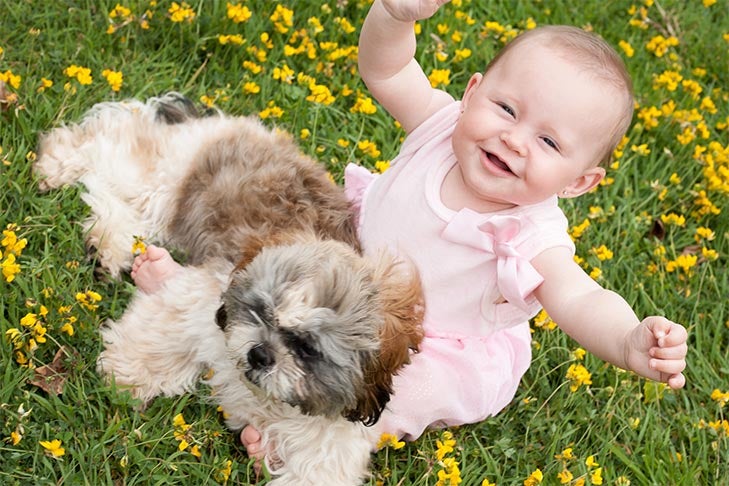
Dee S. writes that she’s concerned about how her dog is acting around her 6-month-old baby. “He mouths her feet, sniffs and licks her head, hands, and feet. He takes her socks off. Is he being protective or jealous?” AKC GoodDog! Helpline Trainer Paisley Lunchick offers up some advice.
It’s always an exciting time when a new baby comes into the house. But for dogs, it can be stressful. When a dog bites a child, it is most often the family pet reacting in his own home. These types of bites are also more likely to cause severe injury. Here are some tips to keep your baby safe and your dog stress-free.
Active Supervision
At no time should a small child be left alone with a dog, no matter the age, breed, size, or temperament of the canine. Dogs are unpredictable animals, and despite domestication, can still have predatory drives. The unusual sounds and unpredictable movements of babies and small children can trigger arousal in any dog and can lead to bites. Even the smallest nip to a baby can be traumatic. Never leave a baby on the floor with a dog, even if you are there next to them. A nervous dog can move very quickly.
Signs Your Dog Is Concerned
Dogs don’t show affection by giving kisses or hugs, and it’s a common myth that licking is a sign of love for a new baby. Licking, sniffing, and mouthing are exploratory behaviors and can be a sign of stress. Never allow your dog to lick or “kiss” the baby. Dogs that are stressed or worried about a baby or toddler give subtle signals that they need space: licking their lips, yawning, turning their head away, furrowing their brows, and ears laid low. A dog won’t necessarily get up and move away from a baby or toddler. That’s why it’s important for an adult to watch for signs of stress in a dog and act quickly to separate the canine and baby, if need be. Do not punish the dog for showing signs of concern. Instead, send him calmly to a bed, crate, or gated area with a fun chew toy.
Success Stations
Before your baby comes home, set up areas where your dog can relax away from chaotic activity in the house. Crates and baby gates can be used to provide your dog with a feeling of safety. Give him high-value treats, chews, and toys that he can have in these areas. When you cannot actively supervise your dog with your baby, send him to one of these spots.
Our dogs are cherished members of the family, sharing our lives and providing unconditional love. But all dog owners know that our canine partners have different perspectives on life than we do.
If you have ever asked, “Why does my dog do that?” then this feature is for you. The AKC GoodDog! Helpline training team will answer your questions on dogs’ behavior and offer training advice to help you and your pup have the best relationship possible. The AKC GoodDog! Helpline is a seven-day-a-week telephone support service staffed by professional dog trainers. For more information on the service and how to enroll, go to www.akcgooddoghelpline.org.

